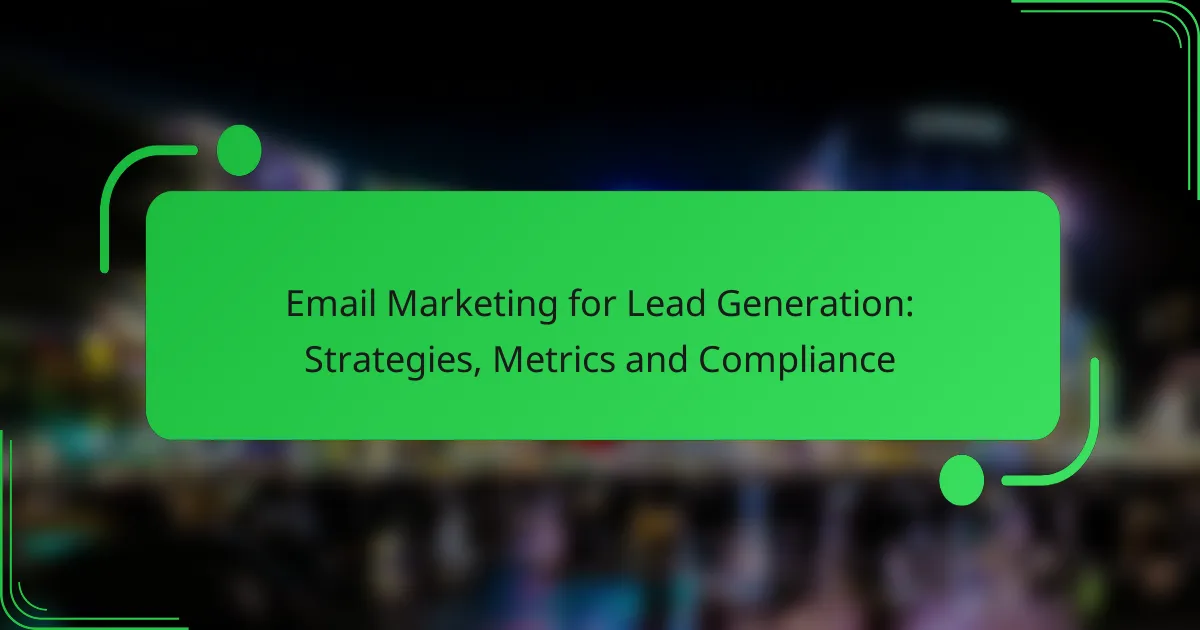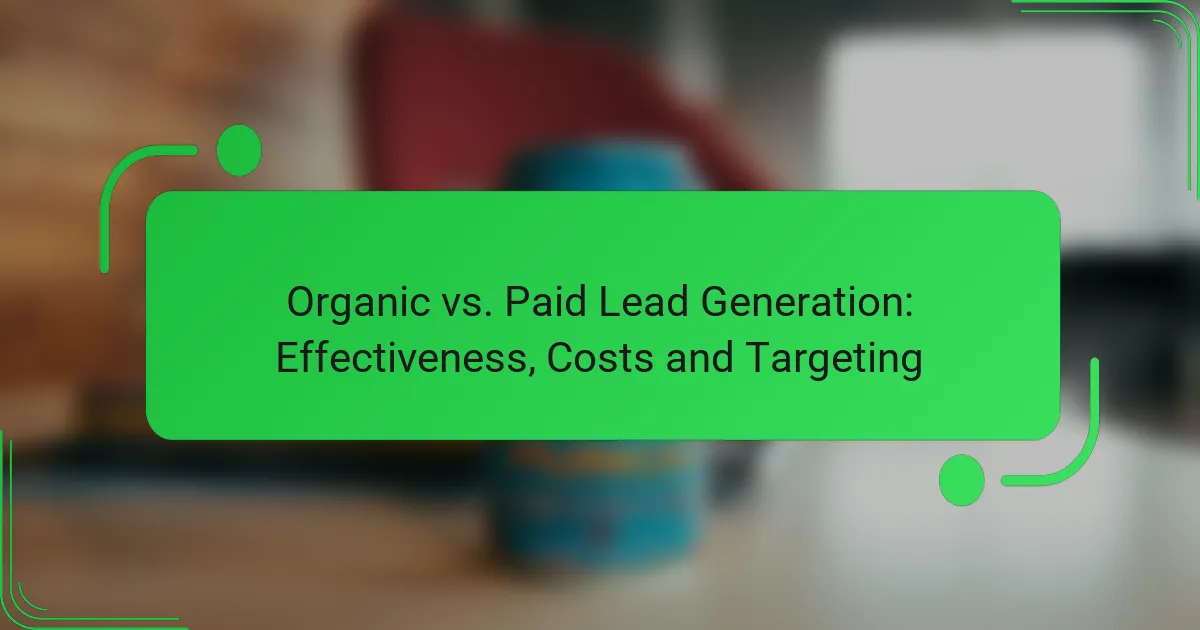Choosing the right lead generation channel is essential for maximizing your marketing efforts and achieving business goals. By evaluating industry fit, audience reach, and budget constraints, businesses can identify the most effective strategies for connecting with potential customers. Each channel, from email marketing to social media advertising, offers unique advantages that can be tailored to specific target audiences and financial resources.

Which lead generation channels are most effective in Canada?
In Canada, effective lead generation channels include email marketing, social media advertising, content marketing, search engine optimization, and PPC advertising. Each channel has unique strengths and considerations that can align with different business goals and target audiences.
Email marketing
Email marketing remains a powerful tool for lead generation in Canada, allowing businesses to engage directly with potential customers. By building a targeted email list, companies can send personalized messages that resonate with their audience’s interests.
To maximize effectiveness, segment your email list based on demographics or behavior. Aim for open rates in the low twenties to low thirties percent range, and ensure compliance with Canada’s Anti-Spam Legislation (CASL) to avoid penalties.
Social media advertising
Social media advertising is a dynamic way to reach a broad audience in Canada. Platforms like Facebook, Instagram, and LinkedIn offer targeted advertising options that can help businesses connect with specific demographics.
Consider allocating a budget that allows for testing different ad formats and targeting strategies. Monitor engagement metrics such as click-through rates and conversions to refine your approach and maximize ROI.
Content marketing
Content marketing focuses on creating valuable content to attract and engage potential leads. In Canada, this can include blog posts, videos, and infographics that address the needs and interests of your target audience.
Develop a content calendar to ensure consistent posting and consider SEO best practices to improve visibility. Aim for high-quality, informative content that establishes your brand as a trusted authority in your industry.
Search engine optimization
Search engine optimization (SEO) is crucial for increasing organic traffic to your website. By optimizing your site for relevant keywords, you can improve your rankings in search engine results, making it easier for potential leads to find you.
Focus on both on-page and off-page SEO strategies, such as optimizing meta tags and building backlinks. Regularly update your content to keep it fresh and relevant, which can help maintain or improve your search rankings.
PPC advertising
PPC advertising allows businesses to place ads on search engines and pay only when users click on them. This method can generate immediate traffic and leads, making it a viable option for Canadian businesses looking for quick results.
Set a clear budget and use targeted keywords to ensure your ads reach the right audience. Monitor your campaigns closely to optimize for cost-per-click and conversion rates, aiming for a balance that maximizes your advertising spend.

How to assess audience reach for lead generation?
Assessing audience reach for lead generation involves understanding how effectively your chosen channels can connect with potential customers. This includes evaluating the size and characteristics of your target audience, as well as the platforms they frequent.
Market research tools
Utilizing market research tools can provide valuable insights into audience reach. Platforms like Google Analytics, SEMrush, and social media insights help track user behavior and demographics. These tools can reveal which channels are most effective for your industry and audience.
Consider using surveys or focus groups to gather qualitative data about your audience’s preferences. This can complement quantitative data from research tools, giving you a fuller picture of potential reach.
Demographic analysis
Demographic analysis involves examining the characteristics of your target audience, such as age, gender, income, and location. This information helps tailor your lead generation strategies to specific segments that are more likely to convert.
For example, if your product appeals mainly to young adults, focusing on platforms like Instagram or TikTok may yield better results than traditional channels. Use demographic data to prioritize your marketing efforts effectively.
Customer persona development
Developing customer personas is a crucial step in assessing audience reach. Personas are fictional representations of your ideal customers based on data and insights. They help clarify who your audience is and what channels they are likely to engage with.
To create effective personas, gather data from your existing customers and market research. Include details such as their pain points, buying behavior, and preferred communication methods. This will guide your lead generation efforts to be more targeted and efficient.

What budget considerations impact lead generation channel selection?
Budget considerations play a crucial role in selecting the right lead generation channel, as they determine the feasibility and potential effectiveness of various options. Understanding the costs associated with each channel helps businesses allocate resources wisely and maximize their return on investment.
Cost per acquisition
Cost per acquisition (CPA) refers to the total cost incurred to acquire a new customer through a specific lead generation channel. This metric helps businesses evaluate the efficiency of their marketing spend. For example, if a company spends $1,000 on a campaign that generates 100 leads, the CPA would be $10 per lead.
When assessing CPA, consider both direct costs, such as advertising fees, and indirect costs, like staff time. A lower CPA is generally preferable, but it’s essential to balance this with the quality of leads generated.
Return on investment
Return on investment (ROI) measures the profitability of a lead generation channel relative to its costs. A positive ROI indicates that the revenue generated from leads exceeds the expenses incurred. For instance, if a campaign costs $2,000 and generates $10,000 in sales, the ROI would be 400%.
To improve ROI, focus on channels that yield high-quality leads with a higher likelihood of conversion. Regularly analyze and adjust your strategies based on performance metrics to ensure optimal returns.
Channel-specific expenses
Channel-specific expenses include costs unique to each lead generation method, such as platform fees, content creation, and technology investments. For example, social media advertising may require budget allocation for ad spend and graphic design, while email marketing might involve costs for software subscriptions and list management.
When selecting a channel, evaluate these specific expenses against potential lead quality and volume. It’s advisable to create a detailed budget that outlines all expected costs to avoid overspending and ensure that the chosen channel aligns with your overall marketing strategy.

What criteria should be used to choose a lead generation channel?
Choosing the right lead generation channel involves evaluating criteria such as target audience alignment, channel effectiveness metrics, and budget constraints. Each of these factors plays a crucial role in ensuring that your efforts yield the best possible results.
Target audience alignment
Understanding your target audience is essential for selecting an effective lead generation channel. Consider demographics, interests, and online behaviors to identify where your potential customers spend their time. For instance, if your audience is primarily young professionals, platforms like LinkedIn or Instagram may be more effective than traditional methods.
Utilize tools like surveys or social media analytics to gather insights about your audience’s preferences. This information can guide you in selecting channels that resonate with them, ultimately enhancing engagement and conversion rates.
Channel effectiveness metrics
Evaluating the effectiveness of various channels is critical to maximizing your lead generation efforts. Key metrics to consider include conversion rates, cost per lead, and overall return on investment (ROI). For example, if email marketing yields a higher conversion rate compared to social media ads, it may be worth allocating more resources to that channel.
Regularly analyze these metrics to determine which channels are performing well and which need adjustment. A/B testing can also help refine your approach, allowing you to compare different strategies and optimize your lead generation process.
Budget constraints
Your budget significantly influences the selection of lead generation channels. Establish a clear budget that outlines how much you can allocate to each channel, considering both direct costs and potential returns. For instance, paid advertising may require a larger upfront investment but can lead to quicker results compared to organic methods.
It’s important to balance your budget with your goals. If funds are limited, focus on low-cost channels like content marketing or social media engagement, which can still generate leads effectively over time. Always monitor spending and adjust your strategy as needed to stay within budget while maximizing results.

How do industry specifics influence lead generation choices?
Industry specifics significantly shape lead generation strategies by determining which channels are most effective for reaching target audiences. Factors such as market trends, competition, and regulatory requirements all play a crucial role in selecting the right approach for generating leads.
Industry trends
Staying updated with industry trends is vital for effective lead generation. Trends can dictate which platforms are gaining traction, such as social media channels or industry-specific forums, and can influence the type of content that resonates with potential leads. For example, if video content is trending in your industry, investing in video marketing could yield higher engagement.
Additionally, understanding seasonal trends can help in timing your campaigns. For instance, businesses in retail often see spikes in lead generation during holiday seasons, while B2B services may experience increased interest at the start of the fiscal year.
Competitive landscape
The competitive landscape directly impacts lead generation choices by highlighting which channels competitors are utilizing successfully. Analyzing competitors can reveal gaps in their strategies that your business can exploit, such as underutilized social media platforms or niche marketing opportunities. Tools like competitor analysis software can provide insights into their lead generation tactics.
It’s also essential to differentiate your approach. If many competitors are focusing on paid advertising, consider organic methods like content marketing or partnerships to stand out and attract leads without competing for the same ad space.
Regulatory considerations
Regulatory considerations can heavily influence lead generation strategies, especially in industries like finance, healthcare, and telecommunications. Compliance with laws such as GDPR in Europe or CAN-SPAM in the United States is crucial to avoid legal repercussions and maintain consumer trust. Understanding these regulations can guide how you collect and manage leads.
For example, if your industry requires explicit consent for email marketing, ensure your lead generation forms clearly state this requirement. Failing to comply can lead to fines and damage your brand’s reputation, so always prioritize regulatory adherence in your lead generation efforts.

What are the emerging trends in lead generation channels?
Emerging trends in lead generation channels focus on leveraging technology and data analytics to enhance targeting and engagement. Businesses are increasingly adopting multi-channel strategies that integrate social media, content marketing, and automation tools to reach their audiences effectively.
Industry Fit
Choosing the right lead generation channel depends significantly on your industry. For example, B2B companies often find success with LinkedIn and email marketing, while B2C brands may thrive on platforms like Instagram and Facebook. Understanding where your audience spends their time is crucial for effective lead generation.
Consider the specific characteristics of your industry when selecting channels. Highly regulated sectors, such as finance or healthcare, may require more compliance-focused strategies, while creative industries can benefit from visually-driven platforms. Tailoring your approach to industry norms can enhance credibility and engagement.
Audience Reach
Audience reach is a critical factor in selecting lead generation channels. Assess the demographics, interests, and behaviors of your target audience to determine which platforms will yield the best results. Tools like Google Analytics and social media insights can provide valuable data on where your potential leads are most active.
Utilizing a mix of channels can maximize your reach. For instance, combining paid advertising on social media with organic content marketing can help you tap into different segments of your audience. Regularly review your performance metrics to adjust your strategy and ensure you are effectively reaching your target market.
Budget
Your budget plays a vital role in determining which lead generation channels to pursue. Some channels, like organic social media or content marketing, may require more time than money, while others, such as pay-per-click advertising, can quickly consume a budget. Establishing a clear budget helps prioritize channels that align with your financial capabilities.
Consider starting with a small budget on multiple channels to test which ones yield the best return on investment (ROI). As you gather data, you can allocate more resources to the most effective channels. Avoid overspending on channels without measurable results to ensure sustainable lead generation efforts.



